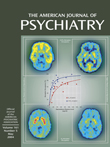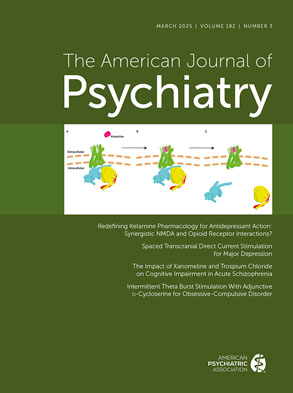To the Editor: Only sparse data exist regarding combination treatments of clozapine with other psychiatric medications or ECT
(1). Here we report on seven patients who received combined application of clozapine and amisulpride. Amisulpride is not marketed in the United States. It acts primarily on dopaminergic D
2 and D
3 receptors of the limbic system. Because of its lower induction of extrapyramidal symptoms and its better efficacy against negative symptoms (compared to typical neuroleptics), it is grouped among the atypical neuroleptics.
Seven patients (four men and three women) with a paranoid-hallucinatory (N=3) or schizoaffective psychosis (diagnosed according to DSM-III-R) gave written informed consent to be treated with clozapine combined with amisulpride. Their mean age was 41.3 years (SD=7.9, range=32–54). In the preceding 12–72 months, each had received neuroleptics from at least three different classes (butyrophenone, thioxanthene, and phenothiazine); in four cases, ECT was also applied. Since no significant improvement had occurred, all patients had been given monotherapy with clozapine; the average length of treatment was 30 weeks (range=8–52). With clozapine (an average dose of 293 mg/day), there was also no significant clinical improvement.
We then decided to administer amisulpride additionally to these patients. Treatment success was monitored with the Clinical Global Impression Scale (CGI) and the Brief Psychiatric Rating Scale (BPRS). The average dose of amisulpride was 543 mg/day (SD=223, range=200–800); comedication included lithium in two cases and lorazepam in three. The addition of amisulpride to clozapine was followed by a decrease in the mean BPRS total score from 50.1 (SD=3.9) to 45.9 (SD=4.6) after a 17-day period (Wilcoxon test: z=–2.02, p<0.05) and to 33.7 (SD=9.3) after an average of 9.7 months (Wilcoxon test: z=–2.20, p<0.03). Global severity of the disease (CGI score) decreased from 6.7 (SD=0.5) to 4.6 (SD=1.1) points (Wilcoxon test: z=–2.20, p<0.03). Treatment response was rated as at least good (CGI score ≥3) in six of seven cases.
A 12-channel ECG was carried out before initiation of amisulpride (baseline) and 17 days later, on average. QTc times were evaluated as described elsewhere
(2). There were no significant changes in ECG time intervals after the addition of amisulpride to clozapine; the mean resting heart rate and mean QTc time both remained unchanged (heart rate: 95.9 bpm versus 93.6 bpm; QTc: 339 msec versus 331 msec). The maximal QTc time was 410 msec. Mean clozapine plasma levels did not differ significantly compared to baseline (the average difference was –28.3 ng/ml).
Even though we could not definitively dismiss that monotherapy with clozapine might otherwise have led in some cases to an improvement in psychosis over long-term treatment
(3), our preliminary data suggest that combined clozapine and amisulpride significantly improves schizophrenia symptoms after a relatively short time. The mechanisms underlying this remain unclear. The dopamine D
2 and D
3 receptor-blocking effects of amisulpride might complement the receptor binding profile of clozapine effectively, and such a combined receptor interaction might trigger an improvement in psychotic symptoms.

